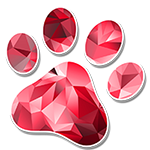The 9th Language
I’m fluent in English and Dutch. I know a few words in German and Welsh and I know even fewer words in French. I know a number of words in Dutch Sign Language, British Sign Language and American Sign Language. In case you didn’t notice, I’m a language nerd.
When Don came to live with me, I added language number nine to my list. The language of the Dog. It’s a very visual language, which is interesting when you only have 5% remaining eyesight. However, Sign Language is also visual and there are many ways for blind people to use it to communicate. So I wasn’t about to let Don’s native language phase me.
First I had to learn about the different things he does with his body and get to understanding what they mean. Like when he sits and holds one foot off the ground, I learned he’s anticipating what’s going to happen next. Either with excitement or nerves. If he sits or lays down when I give him a command, it means he’s confused. When he yawns, he’s trying to relax. When he yawns while simultaniously making a sound, he’s stressed. Almost everything he does with his body has a meaning and it’s my job as his handler to understand it and react appropriately.
Learning to do this while only having 5% remaining vision required me to think out of the box. I only see gross motor movements like sitting or laying down. To see them clearly I have to be at a small distance. 30cm or less. Smaller things such as yawning, I don’t see. So I had to learn to get to know his body. What does it sound like when he sits or lays down. How does it sound when he yawns silently. Yes, even a silent yawn has a sound. I can’t always look, so I had to listen and touch. Laying my hands on his body to feel what he’s doing. Just like I rest my hands on top of my sister’s hands when we’re signing with each other. Only with Don, I’ve learned to associate all the different sounds I hear with the things I was feeling.
Now that I’ve memorized everything I’ve learned, I know why he sometimes doesn’t react appropriately to a command. I then know I need to change the way in which I give the command, or change the position I’m sitting in so that I’m not blocking him from doing what he needs to do. Those silent yawns mean he doesn’t really want cuddles at that moment and I now know exactly what he wants and needs from me.
For some things it’s useful to have a pair of eyes so that I can get a description of what’s happening. Especially when the body language is coming from another dog during our walks. My buddy’s and I have learned the difference between an unhappy dog and a dog that wants to play. Getting a description when a passing dog lays down and an explanation of how it’s laying has helped avoid unwanted confrontation and allowed us to encourage play time.
I’m grateful that I’m becoming fluent in this new language. I have a lot more to learn, but I know I can do it.
Do you understand your furry friend when he’s trying to tell you something?





